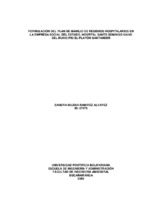Formulación del plan de manejo de residuos hospitalarios en la Empresa Social del Estado Hospital Santo Domingo Savio del Municipio del Playón - Santander
Fecha
2013-07-16Director/Asesor
Kopytko, María Irene
Tipo de contenido
bacherlorThesis
Citación
Metadatos
Mostrar el registro completo del ítemDocumentos PDF
Resumen
El presente trabajo tiene como objeto formulación del plan de gestión integral de residuos sólidos hospitalarios y similares estructurado, en el cual se contemple de forma organizada el manejo de los residuos en las diferentes etapas como son la segregación en la fuente, la recolección, el transporte y el almacenamiento interno. Inicialmente, para el logro del fin mencionado, fue necesario comenzar con la etapa diagnóstica, en la cual a través de listas de chequeo, observación de procedimientos clínicos realizados, entrevistas al personal y caracterización de residuos, se define tanto el tipo y cantidad de residuos generados como las debilidades y fortalezas actuales que presenta el hospital en el manejo de sus residuos a través de la matriz DOFA. El diagnóstico realizado, dio como resultado la presencia de residuos tanto peligrosos (químico y de riesgo biológico) y no peligrosos debido a la naturaleza de las actividades en el Hospital. La mayor cantidad de residuos generados son los residuos no peligrosos reciclables con un 36.7%, seguido por los peligrosos biosanitarios y cortopunzantes con un 35 %. Las revisiones demostraron el incumplimiento de la norma requerida, ya que no realizan una segregación, transporte y almacenamiento adecuado debido al desconocimiento de las características necesarias para un manejo adecuado. Es importante aclarar que aunque el hospital tenía inicialmente la voluntad de mejorar, ya que desde el comienzo aplicaban prácticas de ahorro de energía y uso eficiente del agua, faltaba la orientación por un experto ambiental. Finalmente, conociendo el estado de la institución en el manejo de sus residuos, se realizan y definen capacitaciones, procedimientos, responsabilidades y programas donde se especifiquen las actividades a realizar en cada uno de los niveles jerárquicos del personal implicado, permitiendo garantizar el adecuado manejo de los residuos sólidos desde su generación hasta su disposición final. Lo anterior con el fin de mejorar el manejo de sus residuos y el cumplimiento de lo dispuesto en el artículo 20 del Decreto 2676/2000. This paper aims at formulating the plan for solid waste management of hospitals and similar structures, which provides an organized way of handling waste at different stages such as segregation at source, collection, transport and internal storage. Initially, for the achievement of the purpose mentioned, it was necessary to begin the diagnostic phase in which through checklists, observation of hospital procedures performed, interviews to the staff and characterization of waste is defined as the type and amount of waste generated as current strengths and weaknesses presented by the hospital to manage their waste through the DOFA matrix. The diagnosis resulted in the presence of both hazardous waste (chemical and biological risk) and non-hazardous due to its nature of the activities at the Hospital. The largest amount of waste generated are non-hazardous recyclable waste with 36.7%, followed by the dangerous biosanitary and sharp at 35%. The revisions showed the failure of the standard required and not conducting a segregation, transportation and proper storage due to ignorance of the characteristics necessary for a proper management. It is important to clarify that though the hospital initially had the desire to improve, since the beginning of practices in energy conservation and efficient use of water, it was lacking of guidance by an environmental expert. Finally, knowing the status of the institution in managing its wastes, there are carried out and are defined skills, processes, responsibilities and programs which specify the activities in each of the hierarchical levels of staff involved, which ensures proper management of solid waste from its generation to final disposal. Everything above is designed to improve their waste management and compliance with the provisions of Article 20 of Decree 2676/2000.
Palabra/s clave
Ingeniería ambiental
Tesis y disertaciones académicas
Residuos hospitalarios
Residuos sólidos
Colecciones
- Trabajos de grado [6698]


